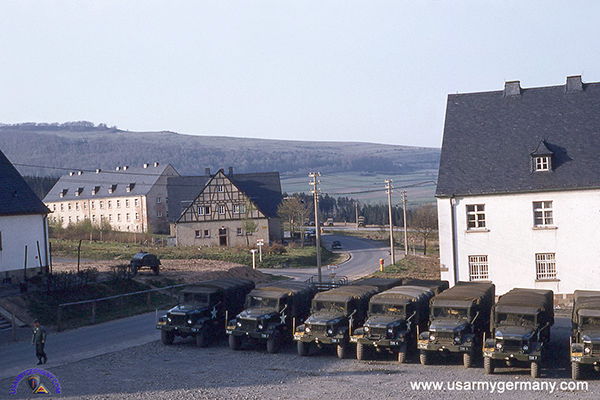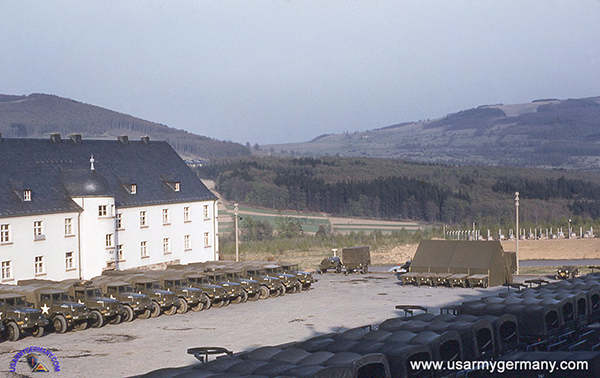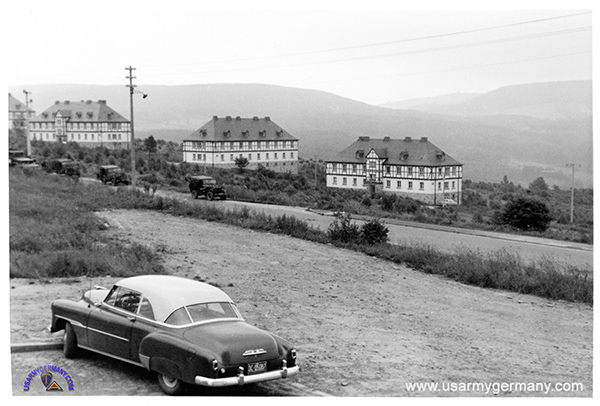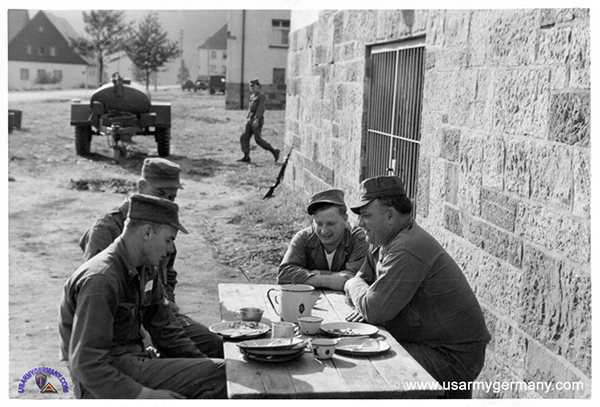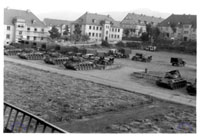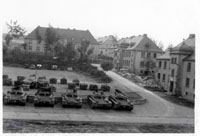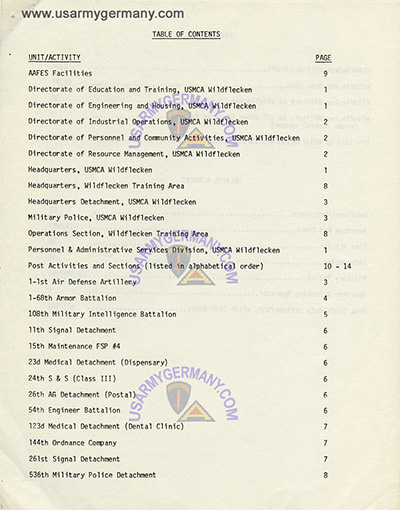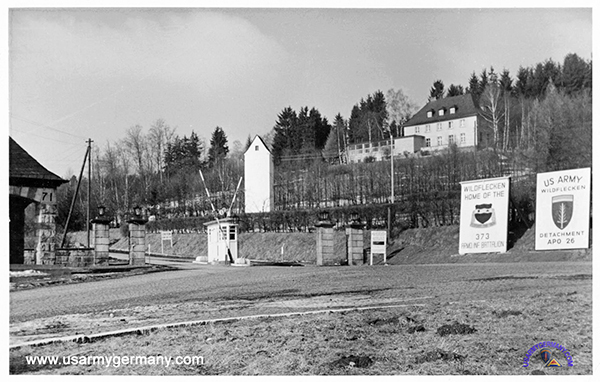Click here to open 'USArmyGermany' frameset
For additions, corrections, or suggestions please contact the webmaster
|
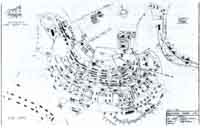 1. Camp Wildflecken, sometime in the 1970s |
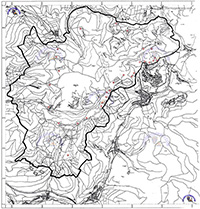 2. Wildflecken Training Area, 1980s |
|
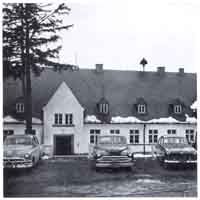 1. 373rd Armd Inf Bn Headquarters Building, 1954 |
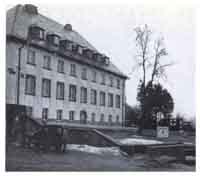 2. Wildflecken Detachment Dispensary, 1954 |
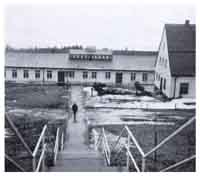 3. Wildflecken NCO Club, 1954 |
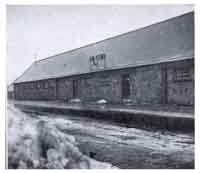 4. EM Club, 1954 |
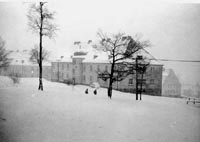 5. Winter in Wildflecken |
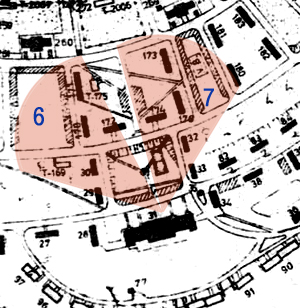 |
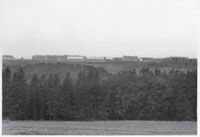 8. Camp Wildflecken from afar, June 1951 |
Additional pages from this particlura eition will be added at a later date.
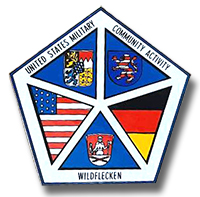 USMCA Wildflecken |
| 7ATC retains MTA at Wildflecken but subcommunity changes to V Corps Milcom by Bob Shipp Wildflecken Training Area and Wildflecken subcommunity parted ways Oct. 1. The training area remained as it has been, a 7ATC subordinate command. The former 7ATC subcommunity became a V Corps community. Of the 475 military and local national personnel, 7ATC retained 159 of these. "The Wildflecken commander formerly wore two hats," explained Lt. Col.(P) James E. Brayboy, director, 7ATC Resource Management, "that of community commander and training area commander. The community part was transferred to V Corps with Col. Henry S. Larsen Jr. as community commander and 7ATC retained the MTA with Maj.(P) Duane Hardesty as commander. "Instead of 7ATC continuing to manage, supervise and operate the community as well as the MTA, V Corps now operates the community. Everything associated with the ranges and training on the ranges belongs to 7ATC." The impact of the transfer is that 7ATC will continue to concentrate on the training effort and V Corps will concentrate on those things associated with housekeeping, base operations and support. The transfer proposal was originally initiated in October 1979 by V Corps. It then went through USAREUR, V Corps and 7ATC channels. At that time the USAREUR Commander in Chief (CINC) decided to delay the decision pending additional analysis. "The transfer was again initiated by V Corps in December 1981," said Brayboy. "Based on that, a number of staff actions and analyses took place and 7ATC was given the opportunity to comment on the proposal in January 1982. "We reviewed it from the 7ATC perspective, primarily one of the impact on training, decided the proposal had merit and concurred. "The CINC then reviewed it, also concurred, and the transfer of the community to V Corps was begun." Then the lengthy process of developing a Table of Distribution and Allowance (TDA) for the community and the training area began. "Prior to the transfer, Wildflecken had a single TDA which encompassed both the community and the training area," explained Brayboy. "The transfer meant that the TDA for the community would have to be transferred to V Corps while 7ATC would retain the training area portion of the TDA. "Meetings took place to define which functions and spaces were in fact purely community and which ones were purely training in nature. Once that was completed, it was a matter of making the appropriate transfer. "The highlight of my working on the project for several months was the fact that both commands were very objective in what they were doing. The theme was that there is really only one Army there and they tried to find the best way to enhance that one Army," he said. Rudi Birkle, management analysis officer, 7ATC Resource Management, was one of the people involved in putting together an acceptable TDA for the Wildflecken transfer. "After many discussions and meetings we came up with a proposed TDA for the MTA," he said. "The Wildflecken Training Area now has a command section, a headquarters detachment and an operating division, which includes Range Control, Range Safety, Targets Branch, Electrical Section, Mechanical Section and a Target Operators Section. "We also have an Engineer Coordinating Branch and a Supply Branch there. Altogether that is 159 people for the training area." As a result of the transfer the 7ATC budget can also be reduced because 7ATC doesn't have the community portion. That portion which affects the community was transferred to V Corps effective Oct. 1. "There is certain support the MTA receives from V Corps," stated Birkle. "We have Memorandums of Understanding stating that V Corps will support certain aspects of the MTA such as engineering, logistics and CPO. Some personnel belonging to the MTA require support from the community side of the house because they live there." Wildflecken straddles two German states: Bavaria and Hessen, Because V Corps, with headquarters in Frankfurt, already supports the area surrounding Wildflecken as well as being physically nearer the area than 7ATC, it was thought it could support the Wildflecken community as well as 7ATC. Since 7ATC is the USAREUR training command, it was decided that the MTA and training should remain with 7ATC. "The fact that there are now two commands in Wildflecken may cause some problems. If there is a problem the local civilian community needs to voice, who do they go to?" commented Birkle. "It used to be that they could go directly to the community commander who could take immediate action. But that is no longer so. Now there will be various channels to go through to get any questions resolved. The community commander and the MTA commander need to work closely together in this respect." As the MTA commander, Hardesty is responsible for running the training area, the management of troops training there and future programming. "I have no doubt that this transfer will benefit the training area," he said. "Now I just have to focus my attention on one area: training." Hardesty said that range upgrading will be one of the upcoming projects at Wildflecken. "Range 9 will undergo modifications to accept the M2/M3 Bradley vehicle during 1983," he stated. "In 1984 Range 10 will also be upgraded to train M2/M3 crews. "The new ranges will display a larger array of targets and also have their own admin and mess areas. "The largest project now scheduled will be Combined Arms Training Complexes due in 1987. "The biggest challenge for the MTA is long range planning. It must be up to a standard that will serve the new weapons systems that will soon be coming on board," he said. The changeover may take some getting used to for Wildflecken personnel, and many specific procedures are yet to be worked out between 7ATC and V Corps. What is sure is that the training area and the community are moving forward to accomplish the mission and provide a good stable community for all who live and work there. |
| Related Links: DP Camp Wildflecken A great site dedicated to the History of "Durzyn", the "Displaced-Persons-Camp Wildflecken" 1945 - 1951. Garrison Wildflecken - Wehrmacht Truppenlager - DP Camp - US Army Training Area (great site!) - Bundeswehr Kaserne Wildflecken Veterans Site |
